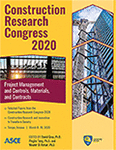Construction Research Congress 2020
Co-Location during Design and Construction of Design-Build Projects: The General Contractor’s Perspective
Publication: Construction Research Congress 2020: Project Management and Controls, Materials, and Contracts
ABSTRACT
Co-location of designers and contractors during the design and construction phases of projects, sometimes referred to as the “big room”, is becoming more prevalent. This surge relates to a proven increase in project success tied to having more integrated and collaborative project teams, which co-location fosters. To date, the literature lacks detailed information on general contractor-specific perceptions of co-location on design-build projects. This paper describes a survey developed and administered by the authors to discern the perceptions of Design-Build Institute of America (DBIA) members regarding co-location. The survey was completed by 112 practitioners working for general contractors in a variety of roles (project managers, estimators, virtual design, and construction managers, etc.) across the United States. Eighty-five percent of the survey respondents felt that co-location adds value to design-build projects. Also, 85 percent of respondents felt that the rate of co-location on projects should be higher than it currently is, as co-location makes both design and construction more effective and efficient, but the determination regarding whether or not to co-locate should be based on the size (related to cost) and complexity of the project. Approximately 80 percent of respondents felt that co-location improves the overall quality and schedule of construction projects, yet only 54 percent felt that co-location reduces project cost. Lastly, the respondents provided substantial commentary concerning barriers to co-location, such as the feasibility of having full-time availability of all project team members (due to some key team members having responsibilities outside of the project at hand, and a lack of desire to be away from their workplaces and families), along with how technology can be leveraged to promote team integration without all team members physically being in the same location. Future research includes comparing the general contractor perceptions to those of trade contractors, owners, and designers.
Get full access to this article
View all available purchase options and get full access to this chapter.
ACKNOWLEDGEMENTS
The authors would like to thank the DBIA parent organization, DBIA regional chapters, and their membership for soliciting and providing data for this study.
REFERENCES
Allison, M., Ashcraft, H., Cheng, R., Klawans, S., and Pease, J. (2019). “Integrated Project Delivery: An Action Guide for Leaders.” Charles Pankow Foundation, Center for Innovation in the Design and Construction Industry, Integrated Project Delivery Alliance. Retrieved from https://leanipd.com/integrated-project-delivery-an-action-guide-for-leaders/
Arditi, D., Elhassan, A., and Toklu, C. (2002). “Constructability Analysis in the Design Firm.” J. Constr. Eng. Manage., 128(2), 117-126.
Austin, R., Pishdad-Bozorgi, P., and de la Garza, J. (2016). “Identifying and Prioritizing Best Practices to Achieve Flash Track Projects.” J. Constr. Eng. Manage., 142(2), 14015077.
Dossick, C., Neff, G., and Homayouni, H. (2009). “The Realities of Building Information Modeling for Collaboration in the AEC Industry.” Construction Research Congress, Seattle, Washington.
Gibson Jr., G.E., O’Connor, J., Migliaccio, G., and Walewski, J. (2007). “Key Implementation Issues and Lessons Learned with Design-Build Projects.” In Alternative Project Delivery, Procurement and Contracting Methods for Highways. American Society of Civil Engineers, Reston.
Gransberg, D., Koch, J., and Molenaar, K. (2006). Preparing for Design-Build Projects: A primer for Owners, Engineers, and Contractors. American Society of Civil Engineers, Reston.
Konchar, M., and Sanvido, V. (1998).“Comparison of U.S. Project Delivery Systems.” J. Constr. Eng. Manage., 124(6), 435-444.
Leicht, R. M., Molenaar, K. R., Messner, J. I., Franz, B. W., and Esmaeili, B. (2016). Maximizing Success in Integrated Projects: An Owner’s Guide. Version 1.0, January, The Pennsylvania State University. Available at http://bim.psu.edu/delivery
Molenaar, K., and Franz, B. (2018). “Revisiting Project Delivery Performance 1998 – 2018.” Charles Pankow Foundation and Construction Industry Institute. Retrieved from https://dbia.org/wp-content/uploads/2018/11/Cost_Performance_Research-CII_Pankow2018.pdf
Pishdad-Bozorgi, P., de la Garza, J., and Austin, R. (2016). “Readiness Assessment for Flash Tracking. J. Constr. Eng. Manage., 142(12), 06016005.
Pishdad-Bozorgi, P., Austin, R., and de la Garza, J. (2017). “Network of Flash-Track Practices.” J. Constr. Eng. Manage., 33(1), 04016024.
Pulaski, M., and Horman, M. (2005). “Organizing Constructability Knowledge for Design.” J. Constr. Eng. Manage., 131(8), 911-919.
Vidal, L., and Marle, F. (2008). “Understanding project complexity: implications on project management.” Kybernetes. 2008(37), 1094-1110.
Vidal, L., Marle, F., and Bocquet, J. (2011). “Using a Delphi process and the analytic hierarchy process (AHP) to evaluate the complexity of projects.” Expert Systems with Applications. 2011(38), 5388-5405.
Vidal, L., Marle, F., and Bocquet, J. (2011b). “Measuring project complexity using the analytic hierarchy process.” International Journal of Project Management. 2011(29), 718-727.
Information & Authors
Information
Published In
Construction Research Congress 2020: Project Management and Controls, Materials, and Contracts
Pages: 1194 - 1202
Editors: David Grau, Ph.D., Arizona State University, Pingbo Tang, Ph.D., Arizona State University, and Mounir El Asmar, Ph.D., Arizona State University
ISBN (Online): 978-0-7844-8288-9
Copyright
© 2020 American Society of Civil Engineers.
History
Published online: Nov 9, 2020
Published in print: Nov 9, 2020
Authors
Metrics & Citations
Metrics
Citations
Download citation
If you have the appropriate software installed, you can download article citation data to the citation manager of your choice. Simply select your manager software from the list below and click Download.
